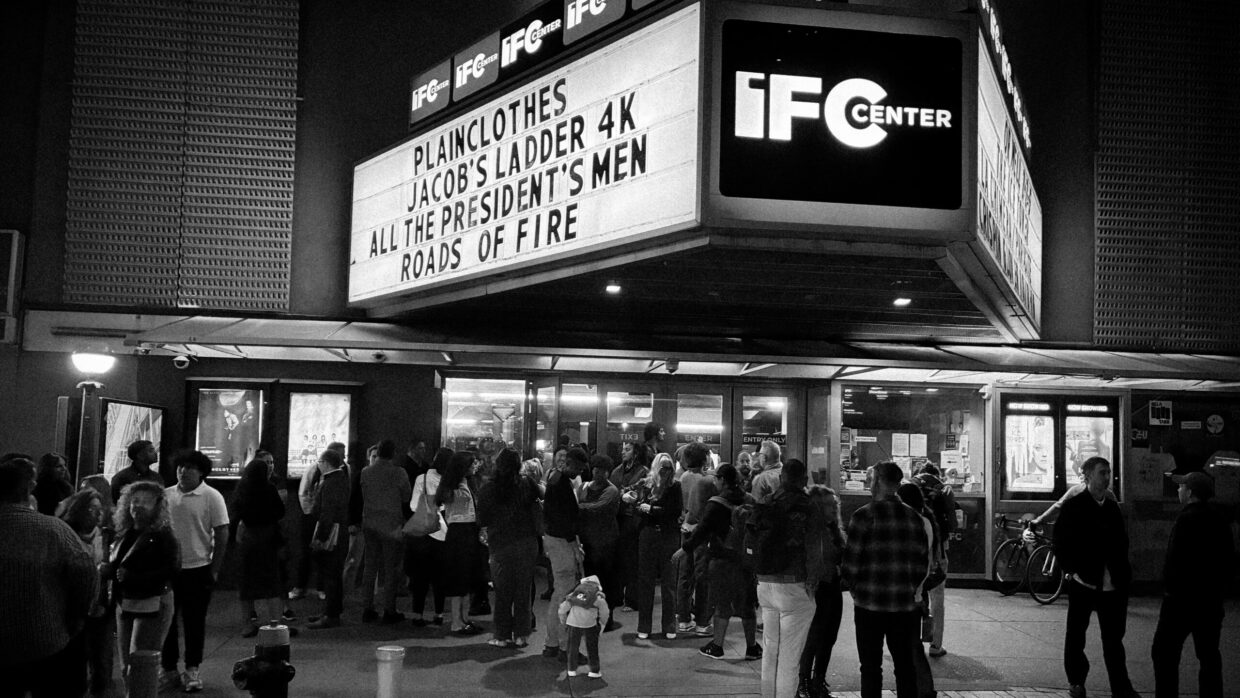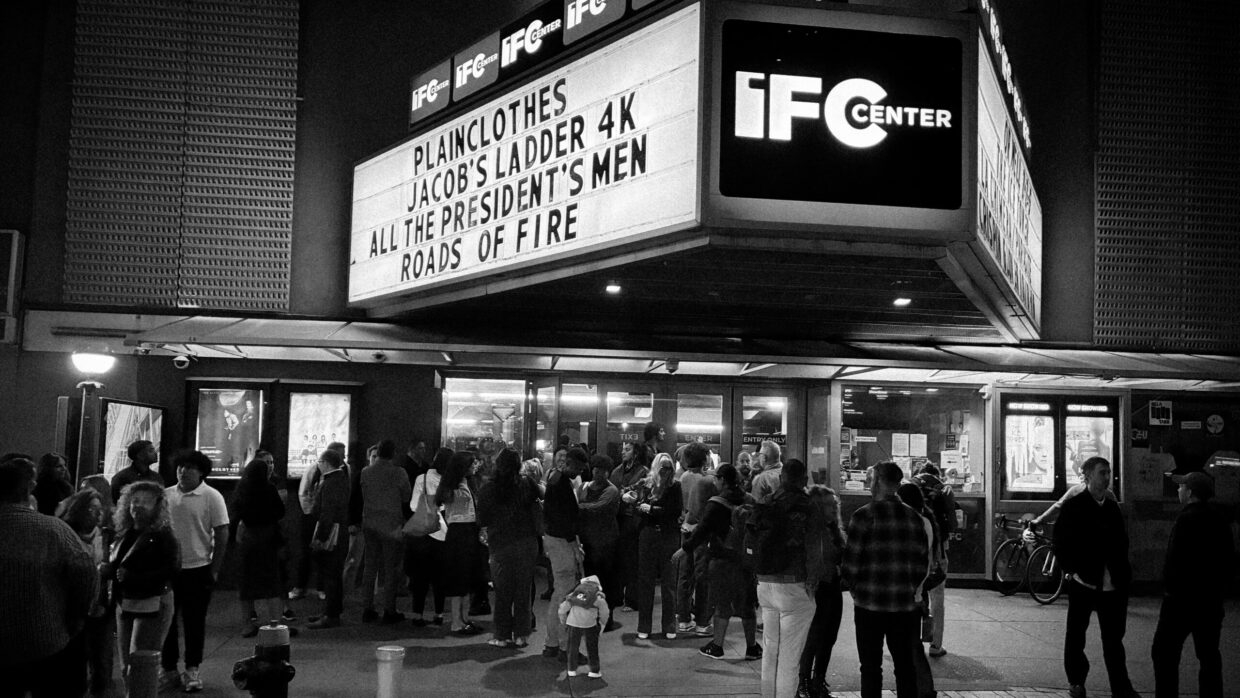 Photo: Nathaniel Lezra
Photo: Nathaniel Lezra
My relationship with the stretch of Sixth Avenue running between West 3rd and West 4th Streets, on one corner of which stands New York City’s legendary IFC Center, mirrors my relationship with cinema, bad tattoos, crushing hangovers, and a whole mess of memories that sit in the back of my brain like luggage stuffed in a collapsing mid-flight Ryan Air jet. The relationship is complicated, messy in an overloaded-Papaya-Dog sort of way, and something I profoundly cherish.
I’ll back up. I won’t recount the full history of the IFC Center, or that stretch of the city — that’s what Wikipedia’s for. I’ll focus on what I can attest to, what I remember, and how that theater, that area, and an era changed me, and so many others.
I’m a documentary filmmaker. The stories I focus on tend to be stories of immigration, labor, and the mental and physical impact of life in 2025. These are often stories of people fleeing war and economic collapse, physical trauma, exploitation, but also of unfathomable courage, skill, and community. Stories of people starting over, or doing what they can. I recently had the privilege of opening a film at IFC, a project I directed called Roads of Fire, and when I had a second to breathe, I stepped away from the theater and walked up the block. It got me thinking. This is where the memories, movies, tattoos, dreams, romance and carnage and general weird shit I mentioned start to collide.
I spent my childhood in many places, but, starting around 14, much of it was spent within 100 yards of IFC. At 17, I snuck into a showing of Antichrist (Trier, 2009) with four friends after slamming Coronas with the staff of the Washington Square Diner, one of a few places that didn’t card, and was a frequent gathering spot for insufferable nerds like us. The worst kind – the kind who were in intense denial about their privilege, fancied themselves street kids or punks, yet spent most of their time arguing drunkenly about movies, video games, MF Doom, kung fu, or whatever other inane bullshit crossed our minds. I’ll never forget the taste of popcorn swirled with rum-spiked-Coke that defined that screening. A dirty taste for a dirty film.
Through the haze, we didn’t realize that the city was changing around us, and around IFC. This was also around the start of Michael Bloomberg’s third term as Mayor, an era of NYC municipal politics that would soon shift radically, with DeBlasio coming in a few years later to take a swing at serious housing reform, attempt an economic overhaul in the city, and bring a close to the post-9/11 era. The impact of this moment on the blocks in question is clearer and starker in retrospect. We had no idea what we were even looking at. It was a movie theater next to a sex-and-tattoo hybrid shop called Crazy Fantasy, some other rough and tumble spots, and then Papaya Dog. I should say, I later learned that Crazy Fantasy was in fact called Fantasy Party, Inc. But I like Crazy Fantasy better, it’s what my memory is doing, so I’m going to stick with it. Across the street was the West 4th subway station, the basketball courts, the Diner, and a gaggle of lunatics, hustlers, NYU kids, rumpled professors, and cops trying to stay sane. It was messy and surreal and we took it for granted. A year into film school, I came back over winter break, stayed out until dawn, then got my left forearm tattooed by a shaky-handed employee of Crazy Fantasy, my first tattoo, at about 6:00AM.
A year or two later, Crazy Fantasy was cut in half. I went back and found that a rich people tattoo shop stood where the ink-side of the store had been. Soon after, that shop failed. And then another one appeared, and another. Restaurants came and went. Crowded to empty, the 99-cent slice crawling higher and higher in pricing, if not in quality. But still good in a pinch.
Like a lot of people, during those winters, I was often berated into seeing It’s a Wonderful Life (Capra, 1946) at the IFC midnight screenings. This was a foundational point of love and irritation for me. Friends, ex-girlfriends, family members. Everyone wanted and still wants to see this fucking movie, always in winter, always when it’s awful out, and it’s always steeped in saccharine meaning for them. For me, I tolerated the naked sentimentality of the film – while obviously secretly loving it, particularly the bank run scene. That bank run scene ran parallel and analogous to that moment in NYC, as the mortgage crisis had hit, and we were living in the fallout. The economy had bottomed out, the blocks were changing, the unhoused rates were spiking, bankers were being bailed out, and things were only climbing in price, anxiety, and pain. I look back on It’s a Wonderful Life fondly – not because I give a shit about Bedford Falls, or the blissful white people jumping for joy all over the place, but because it brings me back to sitting with those I knew then – people who cared so much, all of us living through cataclysmic change, thinking we knew more than we did, caught in a romantic limbo of ignorance.
IFC is still there, and doing well, at least from an outside perspective. Young people still staff it, and people still pack it out. I can attest to that. We sold out almost every showing of Roads of Fire, and I saw people I hadn’t seen in years, some even since those high school and early college days, the Crazy Fantasy days. I’m not a particular sucker for nostalgia, but leaving the theater to breathe and look back at that block, that run of stores and memories and ghosts, the feeling hit. Then I saw a drunk kid hunch over the trash can outside Papaya Dog and puke, his friends laughing from inside. I suppose I almost cried.
The IFC has been near the center of so many moments in my life. So has that block, and so have the people that pack it – the drunks, hustlers, students, workers, immigrants, teachers, asshole, basketball players and beyond. Being in the heart of that mess of humanity was what brought me to filmmaking as a mechanism of looking at life. If there’s anything I intend for this piece, it’s to urge the reader – whether you’re a film person, or not – to drop by the IFC, and that stretch of Sixth Avenue between West 3rd and West 4th. You’ll find yourself stumbling through history’s smoke into a theater that has stood the punishing test of time, and participating in a dirty and wonderful legacy you’ll never forget.

